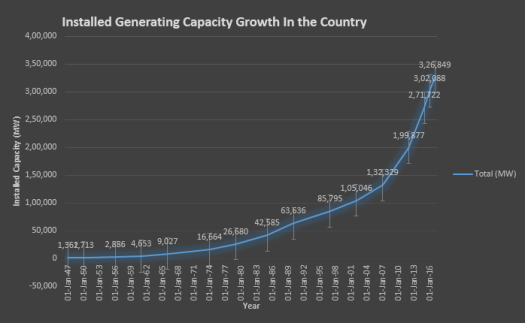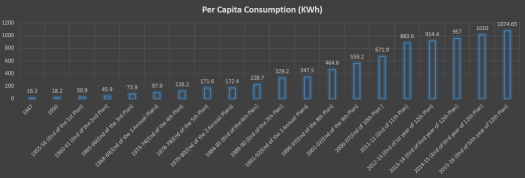Note:
- This particular analysis is not to spark any Political debate but to measure the health of the sector.
- This Article is a part of my Internship research on “Power Industry In Europe, Asia, North and South America”.
The power sector acts as the backbone of an economy through consistent supply of electricity and caters to every division of the economy. Hence, it is peremptory to assess the evolution of this sector—and its role in the development of the country. According to Ministry of Statistics and Programme Implementation Gross Domestic Product (GDP) at constant (2011-12) prices in the year 2016-17 is likely to attain a level of Rs. 121.65 lakh crore. There is a strong correlation between the GDP growth and increase in power generation capacity of an economy. During 2014-15, around 2.41% of the industrial sector share (30.02% in GDP) equated to the contribution of the electricity generation sector.
According to Central Electricity Authority [May 2016] the gross electricity generation increased from 1,713 MW in Mar 1950 to 3, 26,894 MW in Mar 2017 with transformative reforms from states.

Electricity Consumption in India under Utility and Non- Utility Sector increased from 4182 GWh in 1947 to 10, 31, 642 GWh at end of 4th Year of 12th Plan. Per capita Consumption increased from 16.3 KWh in 1947 to 1074 KWh at end of 4th Year of 12th Plan. As comforting as it may sound, around 20 -25 % of the population today still does not have access to electricity.
As per the Central government data the 97.9 per cent, 99.5 per cent and 95.3 per cent of the villages in Bihar, Uttar Pradesh and Assam, respectively, have been deemed ‘electrified’. Yet, as per the data provided by the governments of Bihar, Uttar Pradesh and Assam, 82.84 per cent, 72.97 per cent and 62.93 per cent of their rural households, respectively, are still without any access to electricity.
Reason for the same is, As per the government’s 2006 rural electrification policy, a village is deemed ‘electrified’ if basic infrastructure such as distribution transformer and distribution lines has been set up in the inhabited locality, including a ‘Dalit basti’. Moreover, at least 10 per cent of the households of such a village should have access to electricity through the basic infrastructure established. Nowhere does the definition talks about actual electricity connection or its supply to the household.

Through 2005 Rajiv Gandhi Grameen Vidyutikaran Yojana (RGGVY) UPA Govt. claimed to electrify approximately 1.05 lakh villages out of 1.25 lakh villages that were unelectrified in 2005. Then in November 2015, the Union Cabinet introduced Deen Dayal Upadhyaya Gram Jyoti Yojana (DDUGJY). RGVVY — which dealt purely with electrification — was subsumed under it. Its task is to complete 1st phase of Rural Electrification in next 1000 days. (2nd Phase Signify Intensive Electrification- After electrification of the village, intensification works are taken up till 100 per cent households are electrified).
The top five states which have got largest number of un-electrified rural households are Bihar, Uttar Pradesh, Assam, Jharkhand and Odisha. Till Sept. 2016 the top five states which have got the highest number of un-electrified Below Poverty Line (BPL) households currently are Uttar Pradesh, Bihar, Jammu and Kashmir, Madhya Pradesh and Manipur. As per REC data, only 57 per cent of the country’s rural BPL households have been electrified.
Some states like Gujarat and Andhra Pradesh have been highly successful in rural household electrification as compared to others. Why?
If we keep aside factors like Left wing Extremism and Forests, The Questions that arise from this Analysis is – Does Rural electrification is a concurrent subject and prime responsibility lies with states, their Policies and Willingness.

In the end I would like to conclude that Power Sector in India has grown significantly since independence both in the installed electricity generating capacity and transmission & distribution (T&D) system. CEA has taken a lead and immensely contributed in the national endeavour of development of power sector in various specific areas such as introduction of new technologies, techno-economic clearance of projects, generation & transmission planning including green energy corridor and operation & construction monitoring of projects, design & engineering and dissemination of data & information.
Growing peaks in the graphs reinforce claims of Power Ministry and State govt., the details gives the claims some verisimilitude but it appears to be Hallucinations behind mask of fidelity.
Credits: Abhishek Gautam (PGDM|Marketing)
E-mail Id: abhishekgt99@gmail.com




Nice logan
LikeLiked by 1 person
Follow us
LikeLike